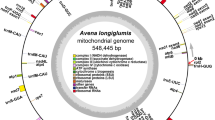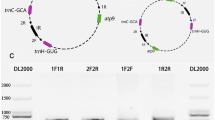Abstract
The complete mitochondrial genome sequences of Brassica species have provided insight into inter- and intraspecific variation of plant mitochondrial genomes. However, the size of mitochondrial genome sequenced for Brassica oleracea hitherto does not match to its physical mapping data. This fact led us to investigate B. oleracea mitochondrial genome in detail. Here we report novel B. oleracea mitochondrial genome, derived from var. capitata, a cabbage cultivar ‘‘Fujiwase’’. The genome was assembled into a 219,952-bp circular sequence that is comparable to the mitochondrial genomes of other Brassica species (ca. 220–232 kb). This genome contained 34 protein-coding genes, 3 rRNA genes and 17 tRNA genes. Due to absence of a large repeat (140 kb), the mitochondrial genome of ‘‘Fujiwase’’ is clearly smaller than the previously reported mitochondrial genome of B. oleracea accession ‘‘08C717’’ (360 kb). In both mitotypes, all genes were identical, except cox2-2, which was present only in the Fujiwase type. At least two rearrangement events via large and small repeat sequences have contributed to the structural differences between the two mitotypes. PCR-based marker analysis revealed that the Fujiwase type is predominant, whereas the 08C717 type coexists at low frequency in all B. oleracea cultivars examined. Intraspecific variations in the mitochondrial genome in B. oleracea may occur because of heteroplasmy, coexistence of different mitotypes within an individual, and substoichiometric shifting. Our data indicate that the Fujiwase-type genome should be used as the representative genome of B. oleracea.




Similar content being viewed by others
References
Allen JO, Fauron CM, Minx P, Roark L, Oddiraju S, Guan NL, Meyer L, Sun H, Kim K, Wang C et al (2007) Comparisons among two fertile and three male-sterile mitochondrial genomes of maize. Genetics 177:1173–1192
Alverson AJ, Zhuo S, Rice DW, Sloan DB, Palmer JD (2011) The mitochondrial genome of the legume Vigna radiata and the analysis of recombination across short mitochondrial repeats. PLoS One 6:e16404
Bergthorsson U, Adams KL, Thomason B, Palmer JD (2003) Widespread horizontal transfer of mitochondrial genes in flowering plants. Nature 424:197–201
Bonen L, Gray MW (1980) Organization and expression of the mitochondrial genome of plants. I. The genes for wheat mitochondrial ribosomal and transfer RNA: evidence for an unusual arrangement. Nucleic Acids Res 8:319–335
Chang S, Yang T, Du T, Huang Y, Chen J, Yan J, He J, Guan R (2011) Mitochondrial genome sequencing helps show the evolutionary mechanism of mitochondrial genome formation in Brassica. BMC Genomics 12:497–508
Chen J, Guan R, Chang S, Du T, Zhang H, Xing H (2011) Substoichiometrically different mitotypes coexist in mitochondrial genomes of Brassica napus L. PLoS One 6:e17662
Chétritl P, Mathieu C, Muller JP, Vedel F (1984) Physical and gene mapping of cauliflower (Brassica oleracea) mitochondrial DNA. Curr Genet 8:413–421
Darracq A, Varré JS, Touzet P (2010) A scenario of mitochondrial genome evolution in maize based on rearrangement events. BMC Genomics 11:233
Davila J, Arrieta-Montiel M, Wamboldt Y, Cao J, Hagmann J, Shedge V, Xu YZ, Weigel D, Mackenzie S (2011) Double-strand break repair processes drive evolution of the mitochondrial genome in Arabidopsis. BMC Biol 9:64
Feng X, Kaur AP, MacKenzie SA, Dweikat IM (2009) Substoichiometric shifting in the fertility reversion of cytoplasmic male sterile pearl millet. Theor Appl Genet 118:1361–1370
Fujii S, Kazama T, Yamada M, Toriyama K (2010) Discovery of global genomic re-organization based on comparison of two newly sequenced rice mitochondrial genomes with cytoplasmic male sterility-related genes. BMC Genomics 11:209
Handa H (2003) The complete nucleotide sequence and RNA editing content of the mitochondrial genome of rapeseed (Brassica napus L.): comparative analysis of the mitochondrial genomes of rapeseed and Arabidopsis thaliana. Nucleic Acids Res 31:5907–5916
Janska H, Sarria R, Woloszynska M, Arrieta-Montiel M, Mackenzie SA (1998) Stoichiometric shifts in the common bean mitochondrial genome leading to male sterility and spontaneous reversion to fertility. Plant Cell 10:1163–1180
Kubo T, Newton KJ (2008) Angiosperm mitochondrial genomes and mutations. Mitochondrion 8:5–14
Lowe TM, Eddy SR (1997) tRNAscan-SE: a program for improved detection of transfer RNA genes in genomic sequence. Nucleic Acids Res 25:955–964
Maréchal A, Brisson N (2010) Recombination and the maintenance of plant organelle genome stability. New Phytol 186:299–317
U N (1935) Genome analysis in Brassica with special reference to the experimental formation of B. napus and peculiar mode of fertilization. Jpn J Bot 7:389–452
Palmer JD (1988) Intraspecific variation and multicircularity in Brassica mitochondrial DNAs. Genetics 118:341–351
Palmer JD, Herbon LA (1987) Unicircular structure of the Brassica hirta mitochondrial genome. Curr Genet 11:565–570
Shedge V, Arrieta-Montiel M, Christensen AC, Mackenzie SA (2007) Plant mitochondrial recombination surveillance requires unusual RecA and MutS homologs. Plant Cell 19:1251–1264
Sloan DB, Alverson AJ, Chuckalovcak JP, Wu M, McCauley DE, Palmer JD, Taylor DR (2012a) Rapid evolution of enormous, multichromosomal genomes in flowering plant mitochondria with exceptionally high mutation rates. PLoS Biol 10:e1001214
Sloan DB, Müller K, McCauley DE, Taylor DR, Štorchová H (2012b) Intraspecific variation in mitochondrial genome sequence, structure, and gene content in Silene vulgaris, an angiosperm with pervasive cytoplasmic male sterility. New Phytol 196:1228–1239
Small I, Suffolk R, Leaver CJ (1989) Evolution of plant mitochondrial genomes via substoichiometric intermediates. Cell 58:69–76
Stothard P, Wishart DS (2005) Circular genome visualization and exploration using CGView. Bioinformatics 21:537–539
Tanaka Y, Tsuda M, Yasumoto K, Yamagishi H, Terachi T (2012) A complete mitochondrial genome sequence of Ogura-type male-sterile cytoplasm and its comparative analysis with that of normal cytoplasm in radish (Raphanus sativus L.). BMC Genomics 13:352–363
Woloszynska M (2010) Heteroplasmy and stoichiometric complexity of plant mitochondrial genomes—though this be madness, yet there’s method in’t. J Exp Bot 61:657–671
Woloszynska M, Trojanowski D (2009) Counting mtDNA molecules in Phaseolus vulgaris: sublimons are constantly produced by recombination via short repeats and undergo rigorous selection during substoichiometric shifting. Plant Mol Biol 70:511–521
Zaegel V, Guermann B, Le Ret M, Andres C, Meyer D, Erhardt M, Canaday J, Gualberto JM, Imbault P (2006) The plant-specific ssDNA binding protein OSB1 is involved in the stoichiometric transmission of mitochondrial DNA in Arabidopsis. Plant Cell 18:3548–3563
Acknowledgments
This study was supported in part by the Private University Strategic Research Foundation Support Program, Grants-in-Aid for Scientific Research, Scientific Research (B) (No. 22380008), and the Program for Promotion of Basic and Applied Researches for Innovations in Bio-oriented Industry (BRAIN), Japan.
Author information
Authors and Affiliations
Corresponding author
Additional information
Communicated by S. Hohmann.
Electronic supplementary material
Below is the link to the electronic supplementary material.
294_2014_433_MOESM1_ESM.pdf
Validation of contig linkage by PCR analysis. (A) Map of linkages between contigs. (B) PCR analysis to confirm the linkages. The primer information used for this PCR analysis is described in Supplementary Table 1 (PDF 221 kb)
Rights and permissions
About this article
Cite this article
Tanaka, Y., Tsuda, M., Yasumoto, K. et al. The complete mitochondrial genome sequence of Brassica oleracea and analysis of coexisting mitotypes. Curr Genet 60, 277–284 (2014). https://doi.org/10.1007/s00294-014-0433-2
Received:
Revised:
Accepted:
Published:
Issue Date:
DOI: https://doi.org/10.1007/s00294-014-0433-2




